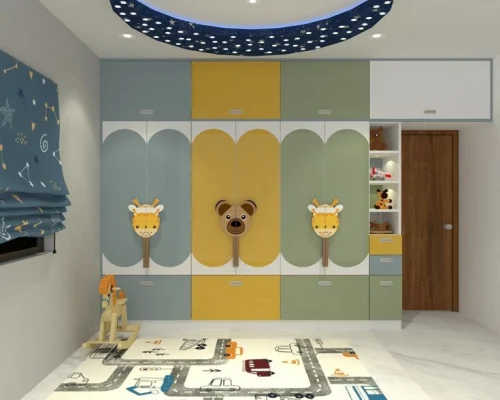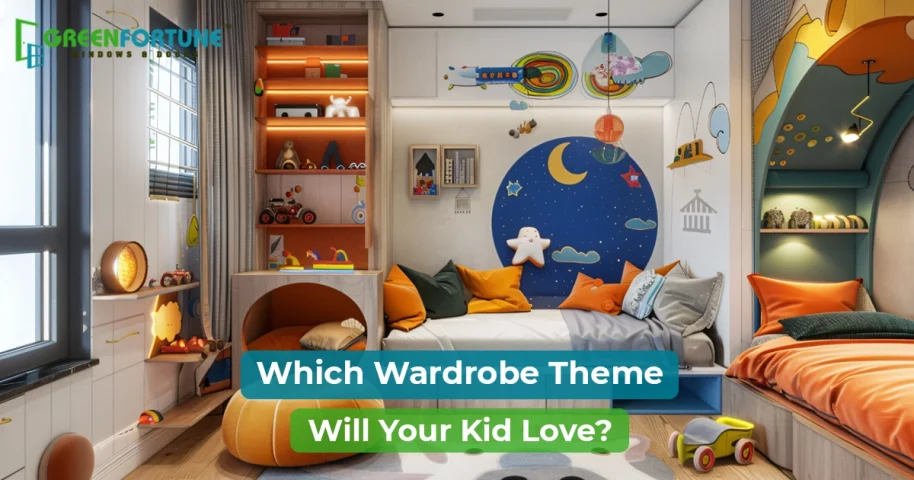
7 Balcony Ceiling Design to Transform Your Outdoor Space
May 8, 2025
Blow Moulded Tank: A Strong and Safe Water Tank for Your Home
May 9, 2025Designing a child’s room is more than picking cute wallpapers or themed beds—it’s about creating a space that supports their imagination, learning, and daily routines. One of the most important (but often overlooked) elements in this process? The wardrobe.
A wardrobe is no longer just a storage box in the corner. Today’s modern wardrobe designs for childrens room combine style, functionality, and fun. From superhero-themed closets to smart, space-saving units that evolve with your child, there's a wardrobe out there to match every little personality.
In this article, we’ll explore five kid-friendly wardrobe design ideas that do more than just store clothes — they spark joy, fuel independence, and keep clutter at bay.
1. Themed Wardrobes for Every Interest

Children are natural dreamers. One moment they're astronauts, the next they’re underwater explorers or princesses. With themed wardrobes, you can bring their fantasies to life — right inside their bedroom.
Popular Themes That Work Wonderfully:
- Superhero-Inspired Wardrobes: Think bold graphics, emblems like lightning bolts or shields, and vibrant colours like red, blue, and gold.
- Fairy Tale Closets: Pastel shades, delicate motifs (stars, butterflies), and even little castle-shaped handles.
- Adventure Zones: Wardrobes shaped like treasure chests, camper vans, or jungle huts — perfect for kids who love a bit of thrill.
Why They Work: Themed wardrobes don’t just look cute. They help kids associate their personal space with excitement and identity. A wardrobe that feels like a spaceship might even make them want to put away their socks. Parenting win, right?
Pro Tip: Choose modular pieces with themed overlays. That way, as their tastes evolve, you can easily switch out the design elements without replacing the whole thing.
2. Interactive and Playful Designs
Functionality is great, but fun matters too, especially in a child’s room. Playful wardrobes encourage interaction, learning, and even a bit of mischief (the good kind).
Creative Ideas to Try:
- Blackboard or Whiteboard Doors: Let your kids doodle, scribble reminders, or play word games right on their closet door.
- Climbing Handles or Built-In Ladders: For wardrobes that go all the way up to the ceiling, adding a climbing element turns putting clothes away into a mini-adventure.
- Mirror and Puzzle Sections: Incorporate shapes and mirrors that not only make the space look bigger but also act as fun, engaging panels.
Why These Rock: Interactive wardrobes develop motor skills, encourage responsibility (think dress-up time), and even foster creativity. And yes — they look very cool too.
This trend in modern wardrobe ideas shows us that design isn’t just about space-saving anymore — it’s about adding elements of joy to everyday routines.
3. Smart Storage for Tiny Rooms (and Growing Kids)
If your kid’s wardrobe currently looks like a tornado hit it, you're not alone. But the good news is, thoughtful storage can solve a lot of those daily battles.
Key Elements of Smart Storage in Kids’ Rooms:
- Adjustable Shelves and Rods: These grow with your child. Start low so they can access their clothes independently, then raise them as they get older.
- Pull-Out Drawers with Dividers: Great for organising socks, innerwear, art supplies, or even toys.
- Hidden Storage Compartments: Use sliding doors, under-the-bed wardrobe extensions, or even ceiling-high units to stash seasonal clothes or items you rarely use.
- Open Display Racks: Combine open and closed shelving to allow kids to display their favourite items — books, trophies, or tiny collections.
Don’t Forget Safety: Use soft-close hinges, anti-tip wall mounts, and rounded corners. No parent wants to deal with trapped fingers or tumbling wardrobes during playtime.
This idea is a staple in modern bedroom wardrobe ideas, where form always follows function, and convenience is king.
4. Colourful and Vibrant Wardrobes
When it comes to children’s rooms, colour is more than decoration — it influences mood, learning, and even behaviour. So it makes sense that modern wardrobe designs for childrens room often use vibrant shades to stimulate creativity and joy.
Some Colour Combos That Work Brilliantly:
- Blue and Yellow: Inspires calm and positivity — great for kids who are a little too high-energy.
- Mint Green and White: A refreshing combination that keeps the room light and soothing.
- Pink and Teal or Lavender and Grey: For a dreamy, modern look that works especially well in shared spaces.
- Multi-Coloured Cubes: Great for toddlers — easy to associate colours with clothing types or activities.
Involve the Kids in Colour Picking: Let them be part of the design process. It’s their space after all — and ownership often leads to better upkeep (well, mostly).
Bold colours are trending in modern wardrobe ideas, especially when combined with minimalist lines and clean finishes.
5. Eco-Friendly and Sustainable Designs
Teaching children about sustainability starts at home. And what better way than designing a wardrobe that’s gentle on the planet?
Sustainable Choices to Explore:
- Reclaimed Wood or Bamboo Panels: Durable, non-toxic, and environmentally conscious.
- VOC-Free Paints: Ensure the wardrobe interiors don’t release harmful fumes.
- Recycled Plastic Organisers: For drawer compartments, baskets, or hanging solutions.
- Modular Designs: Allow for parts to be reused, replaced, or upcycled as your child grows.
Why Go Green? Eco-friendly wardrobes are not only good for the planet, but they also create a healthier environment for your kids. Fewer toxins, better air quality, and long-term usability make these designs a smart (and responsible) choice.
More and more modern wardrobe designs for childrens rooms are going green — and we’re here for it.
Design Mistakes to Avoid
Even with the best intentions, it’s easy to go overboard. Here’s what to steer clear of:
- Too Many Open Shelves: These attract clutter fast and need constant tidying.
- Ignoring Lighting: A poorly lit wardrobe makes it harder for kids to find things on their own.
- Hard-to-Reach Storage: If your child can’t access it, they won’t use it. And you’ll be stuck picking up after them forever.
- Over-theming: Yes, that car-shaped closet is adorable now, but what about in 3 years?
Choose designs that evolve. Opt for flexibility over fixed features.
Final Thoughts
Your child’s wardrobe is more than a place to store clothes — it’s a small but meaningful part of their world. A well-designed wardrobe teaches independence, boosts creativity, and even makes mornings less chaotic.
Whether you’re exploring modern wardrobe designs for childrens rooms or looking for versatile modern bedroom wardrobe ideas, focus on functionality, fun, and future-readiness. Get creative, stay practical, and design a space your little one will enjoy using.
Complete Your Kid's Dream Room with Smart Windows & Doors!
While you’re upgrading wardrobes, don’t forget windows and doors! Green Fortune’s premium uPVC windows and doors keep your child's room bright, comfy, and safe, with better insulation, soundproofing, and security.
Explore modern solutions at thegreenfortune.com to match your fresh designs perfectly!
FAQs
- How can I make a small kids’ room wardrobe more functional?
Use space-saving features like pull-out drawers, overhead cabinets, and corner shelves to maximise vertical space. Modular inserts and adjustable rods make it easier to customise the wardrobe as your child grows. You can also add open bins or labelled compartments to make things more accessible and organised. - Are sliding doors better than hinged doors for children?
Sliding doors are great for small rooms as they don’t take up extra space when opened. They’re also safer for young kids since there’s less risk of slamming fingers. However, it’s important to choose high-quality sliding tracks to prevent jams or accidental detachment. - Can I reuse a baby wardrobe as my child grows?
Absolutely — as long as the wardrobe is modular or has adjustable compartments. You can easily swap out bins, raise shelves, or change the outer finish to suit your child’s evolving needs. This approach is budget-friendly and reduces waste.








